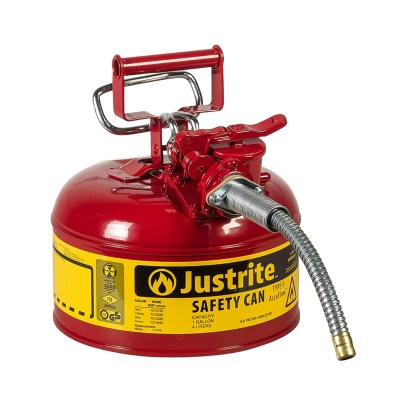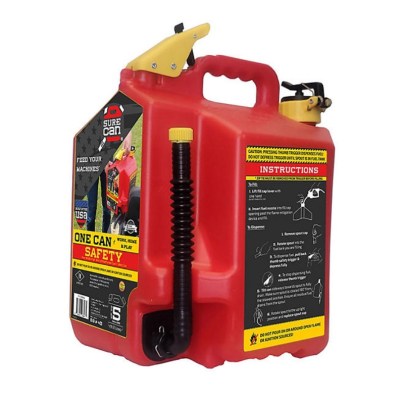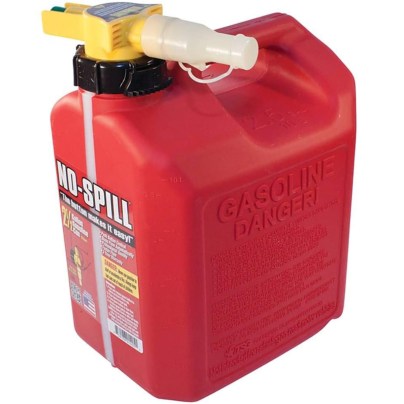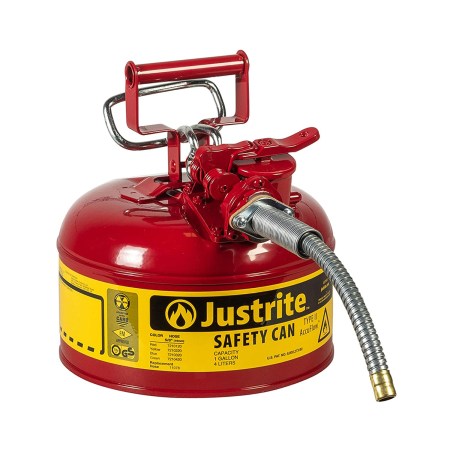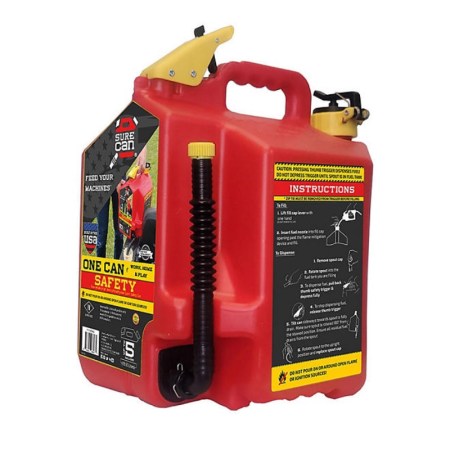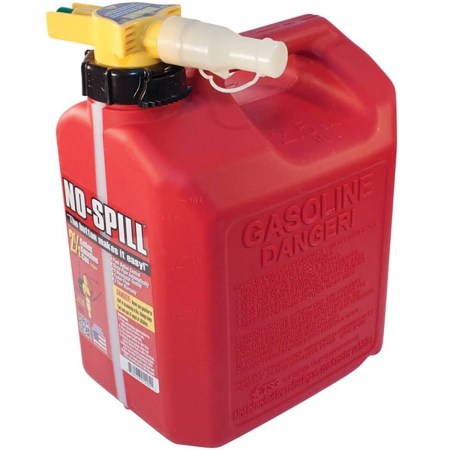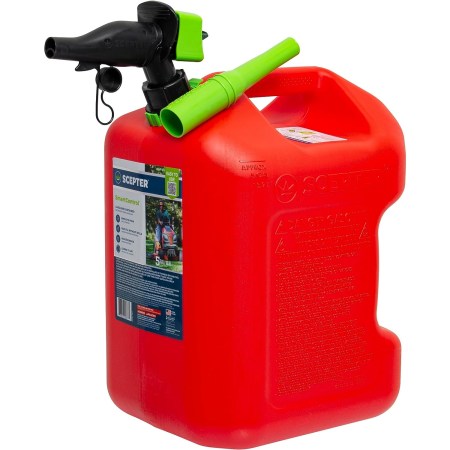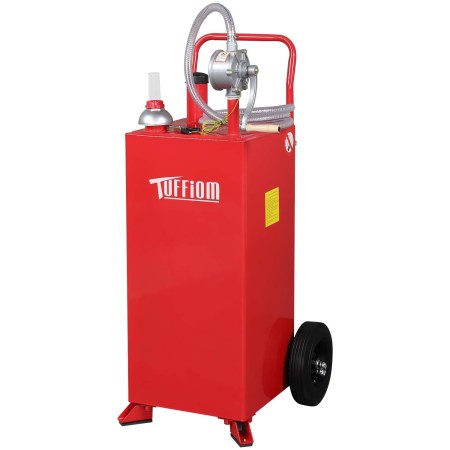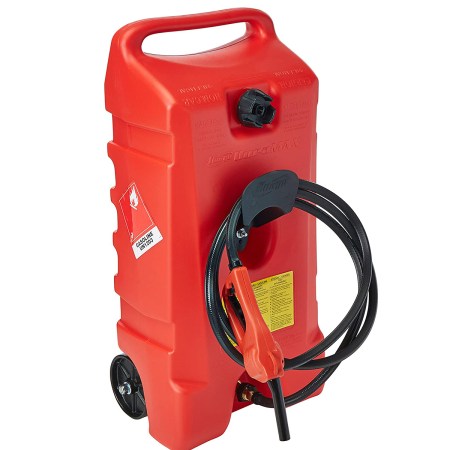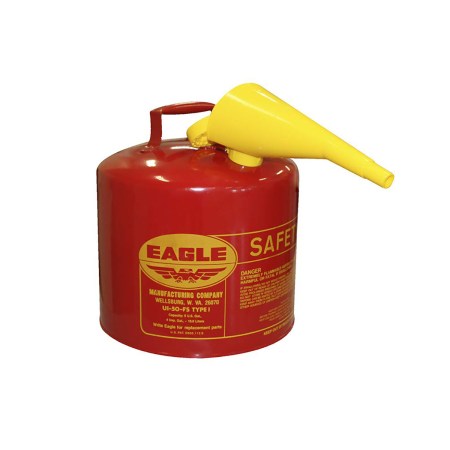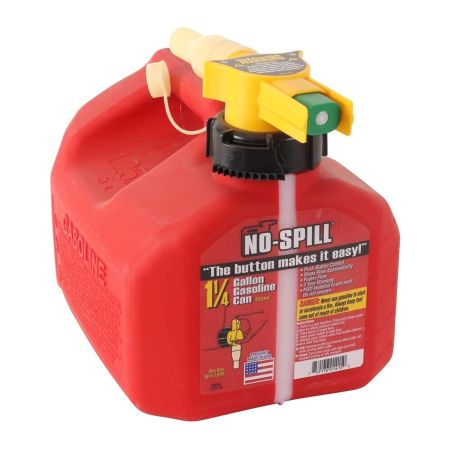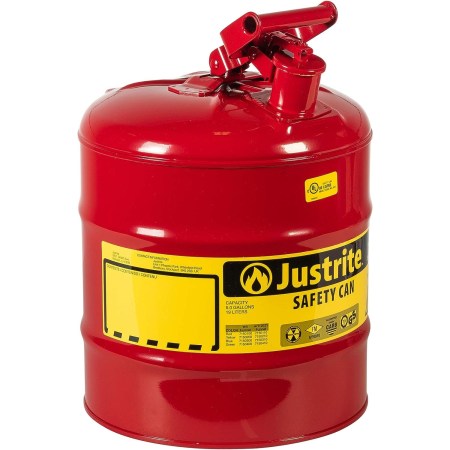We may earn revenue from the products available on this page and participate in affiliate programs. Learn More ›
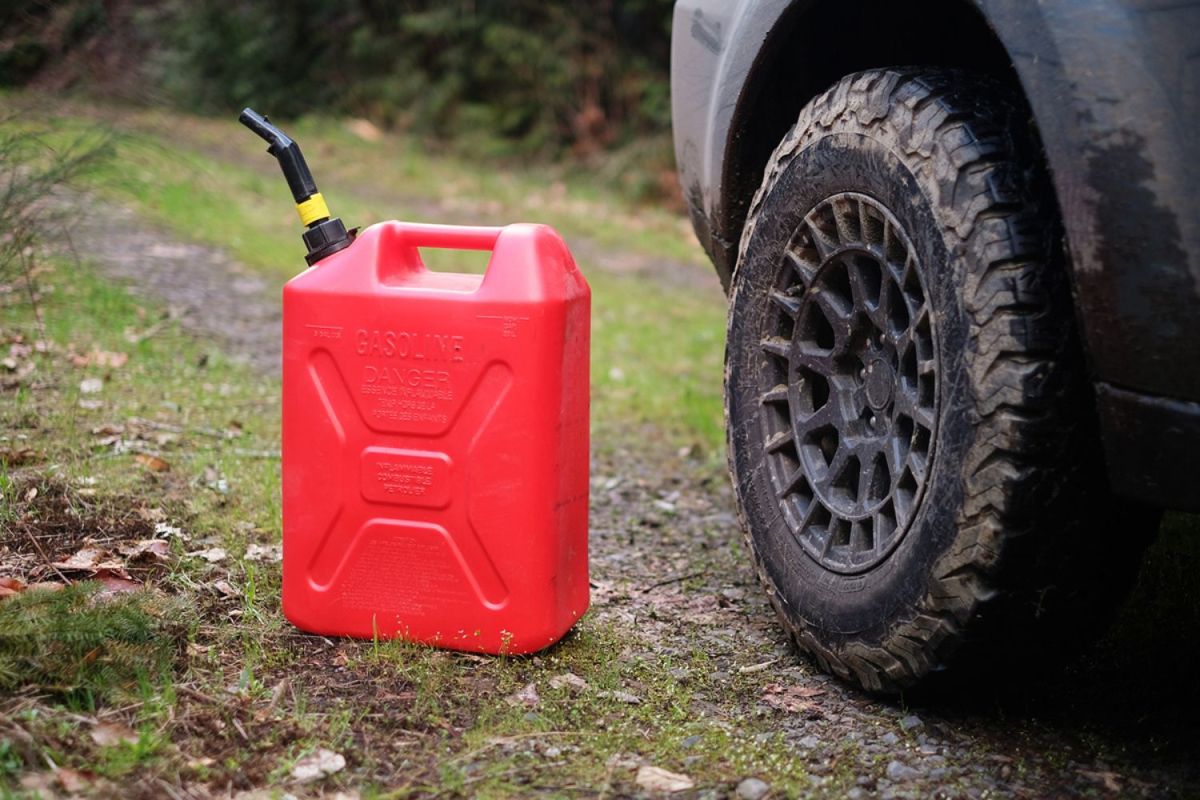
Whether it’s for storing fuel for your power equipment or for emergency preparedness, it helps to have the best gas can for your needs on hand. A high-quality gas can make filling machinery or a generator easier, in addition to providing a safe, leakproof container for storing or transporting fuel.
With so many options available, it can be a challenge to find the right fuel can. It’s important to choose one that is not only easy to fill and pour but also safe and durable. This guide can help you navigate the options and find the best gas can for your specific needs.
- BEST OVERALL: Justrite AccuFlow 1-Gallon Type II Red Safety Can
- RUNNER-UP: SureCan 5-Gallon Gasoline Type II Safety Can
- BEST BANG FOR THE BUCK: No-Spill 1405 2-1/2-Gallon Poly Gas Can
- BEST PLASTIC: Scepter FSCG552 5-Gallon SmartControl Gasoline Can
- BEST HIGH-CAPACITY: Tuffiom 30-Gallon Portable Fuel Storage Tank
- BEST FOR BOATS: DuraMax Flo n’ Go LE 14-Gallon Rolling Gas Can
- BEST FOR GENERATORS: Eagle UI-50-FS Type I 5-Gallon Steel Safety Can
- BEST FOR LAWN MOWER: Stens 765-100 No-Spill 1¼-Gallon Fuel Can
- BEST LONG-TERM STORAGE: Justrite 5-Gallon Type I Steel Safety Can
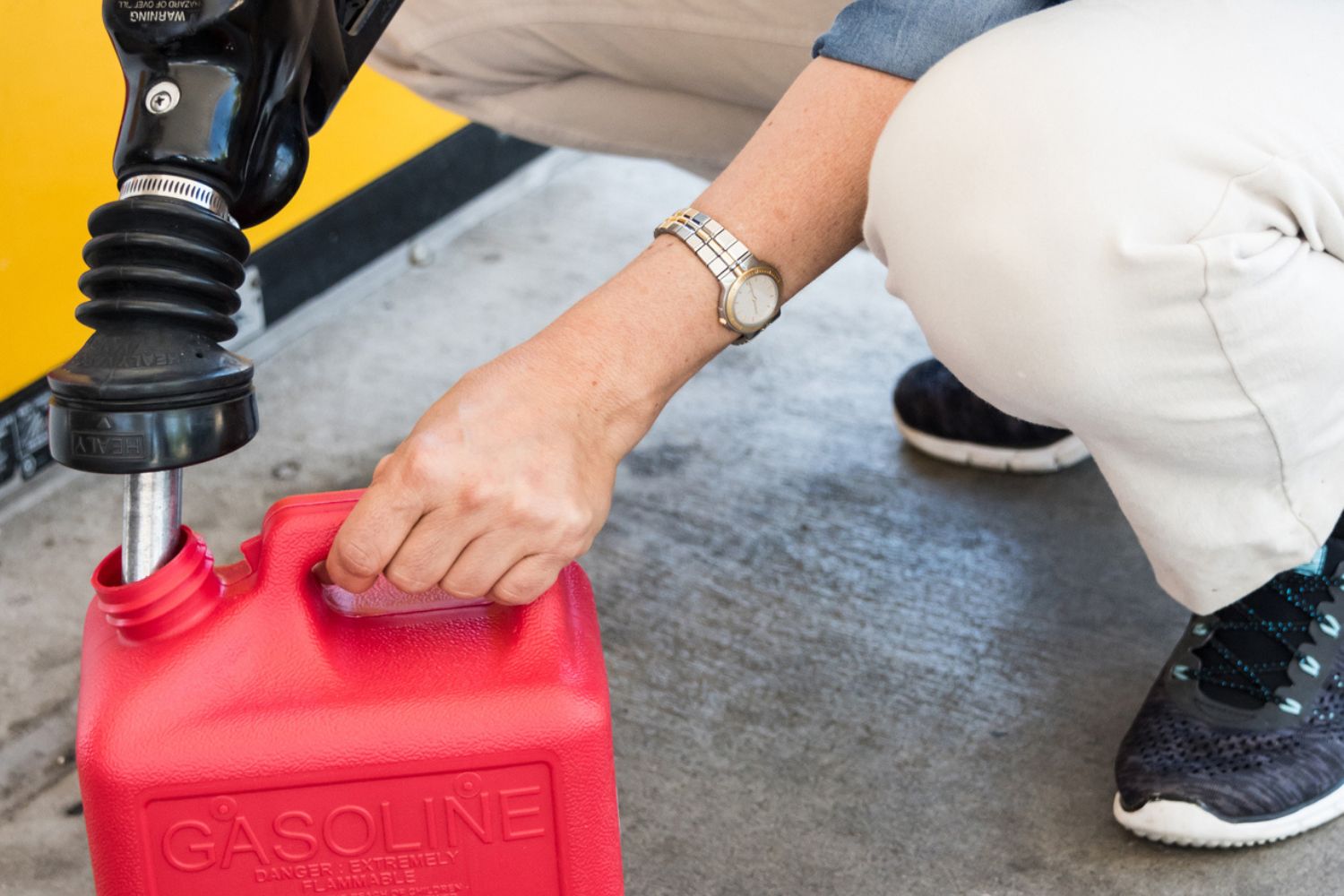
How We Chose the Best Gas Cans
We researched the most sought-after gas cans in their respective categories and discovered that the best models are determined by their construction, safety features, and other special features included by select brands.
While researching the best gas cans available, we found that plastic containers were among the most popular for their compact, lightweight, and ergonomic designs. While less popular, metal gas cans can be a good alternative as they are more durable and include extensive safety features. Regardless of construction, our top picks range from 1 to 30 gallons in capacity to serve the typical range of fuel needs.
Most of our picks include spouts for easy refueling, and some have automatic shutoff or ventilating capabilities. Some of the best options we researched also included flame arresters, spill-proof designs, built-in wheels and handles, siphoning hand pumps, and integrated fuel gauges.
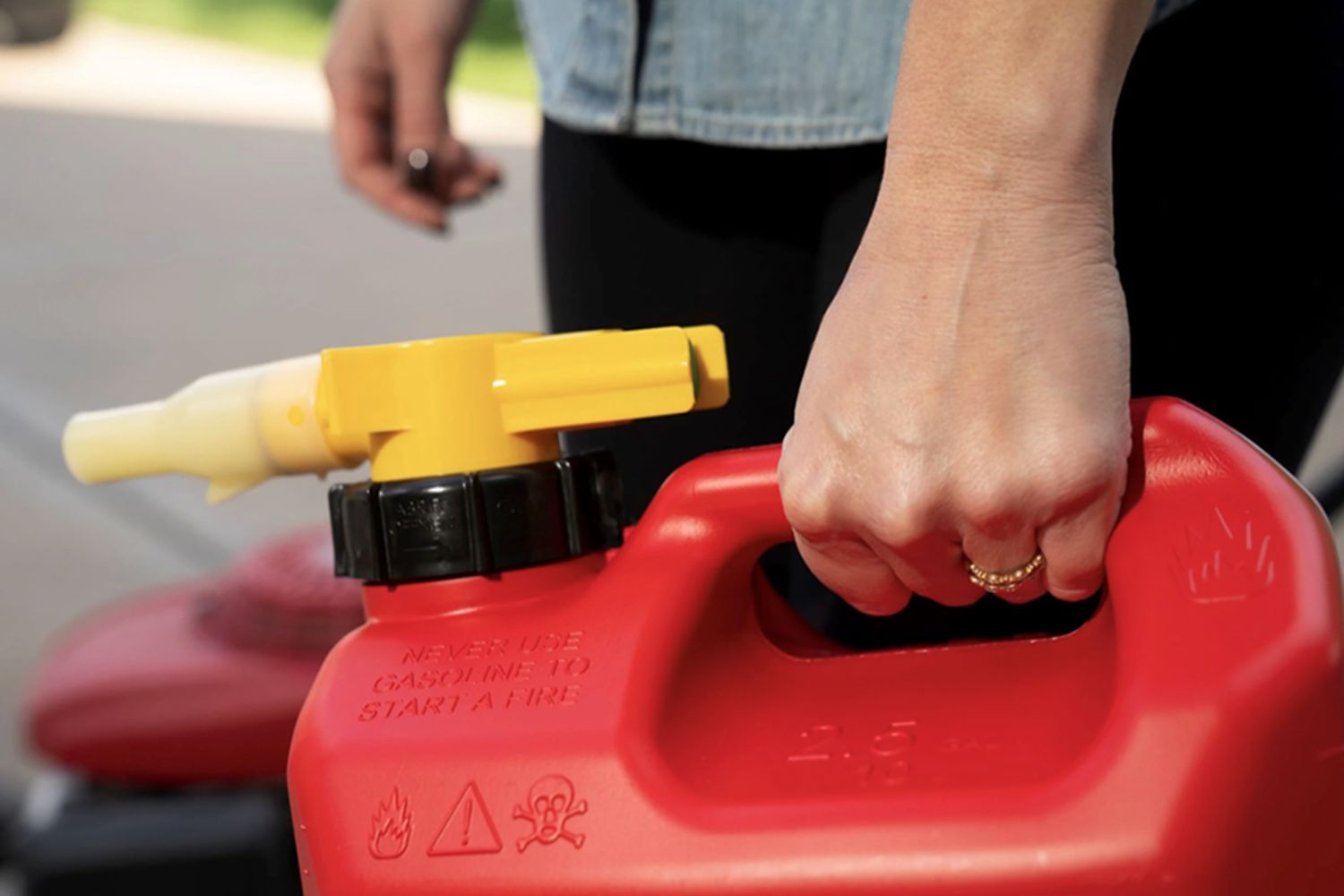
Our Top Picks
After researching a variety of gas cans, we filtered the field of options to a short list that delivered the features that most households need. The following is a list of some of the top products on the market.
Best Overall
Justrite AccuFlow 1-Gallon Type II Red Safety Can
See ItWhen looking for a long-lasting and safe gas can, check out the Justrite Accuflow Type II gas can. This can features Justrite’s Safe-Squeeze trigger handle, allowing users to pour out gas easily and under control. It also has a flexible 9-inch hose that fits into gas tanks and vehicle filler necks with ease.
As a Type II gas tank, it will safely vent when exposed to fire conditions, avoiding dangerous explosions. While it won’t hold a lot of fuel, its 1-gallon size will fit easily on a shelf and is light enough for almost anyone to use. For those who prefer a larger size, shop for Justrite’s 2.5- or 5-gallon model.
Product Specs
- Material: Metal (alloy steel)
- Capacity: 1 gallon
- Pour spout/funnel included: Yes
Pros
- Safe-Squeeze trigger handle makes pouring safe and easy
- 9-inch included hose provides some flexibility and easier reach when filling
- Type II classification so it can self-vent and it’s easy to fill
- Compact, portable size makes transporting it easier than a heavier, bulkier tank
Cons
- It does have a limited capacity, which isn’t ideal for long trips
Get the Justrite AccuFlow gas can at Amazon or Acme Tools.
Runner-Up
SureCan 5-Gallon Gasoline Type II Safety Can
See ItFueling up a vehicle or generator from a gas tank can sometimes require some awkward angles. The SureCan 5-gallon gas can solves that issue with its Easy Pour filling system. The nozzle rotates, allowing users to hold the tank at a comfortable angle, while the thumb-activated trigger allows fuel to pour out at an easily controlled rate.
SureCan’s six-layer design makes this more durable than some of the other plastic tanks. It has a top handle and bottom grips to make pouring even easier. It self-vents, features a childproof cap, and at only 4 pounds when empty, it’s pretty lightweight. However, it is a little bulky at 15.27 inches tall, so it might not be great for small shelves or tight workshops.
Product Specs
- Material: Plastic (high-density polyethylene)
- Capacity: 5 gallons
- Pour spout/funnel included: Yes
Pros
- Easy Pour system with thumb-activated trigger makes filling safe and convenient
- Rotating nozzle allows you to hold the can at a variety of angles
- Durable, 6-layer design won’t break down nearly as quickly as standard plastic cans
- Grips on the top and bottom help facilitate careful pouring at different angles
Cons
- Large construction may be hard to store on a shelf or in a small shop
Get the SureCan gas can at The Home Depot or Sam’s Club.
Best Bang For The Buck
No-Spill 1405 2½-Gallon Poly Gas Can
See ItFor a bit of control when it comes to filling power equipment, the No-Spill 1405 2½-gallon gas can provides it. This can has a thumb-activated push button that allows users to start and stop the flow of fuel into the machine without tipping the tank back and forth. The rigid nozzle fits in most smaller equipment tanks without issue, but it might not reach fuel tanks on larger machines as easily.
This plastic tank has an integrated fuel level gauge called a view stripe so it’s easy to see the remaining amount of fuel at a glance. It also has a large filler neck opening so you can see into the tank to inspect for unwanted debris. This can doesn’t self-vent while being filled, but it does automatically vent while pouring, allowing users to pour up to 3 gallons per minute.
Product Specs
- Material: Plastic (polyethylene)
- Capacity: 2½ gallons
- Pour spout/funnel included: Yes
Pros
- Thumb-activated push button allows you to position the can and then release the fuel
- Integrated view stripe makes it easy to check the fuel level without picking up the can
- Large filler neck opening for refilling to reduce spilling and dripping
Cons
- Pour spout is shorter than comparable options; may not fit larger machines
Get the No-Spill gas can at Amazon, The Home Depot, or Menards.
Best Plastic
Scepter FSCG552 5-Gallon SmartControl Gasoline Can
See ItPlastic gas cans often have finicky fill nozzles and devices, making it hard to hold them with one hand and pour with the other. Scepter’s FSCG552 gas can aims to solve that problem, offering a unique design that allows the free flow of fuel while also being easy to handle. It holds 5 gallons of fuel and comes with a funnel for filling vehicles.
The Scepter FSCG552 features two built-in handles: one on top for carrying and one on the side for pouring. It also includes a push-type fill valve that requires you to unlock a small lever and then push down on the nozzle. This allows you to balance the gas can between your hands.
And, since the nozzle has a free-flowing aeration tube inside, the gas flows smoothly. This can comes in gasoline, diesel, and kerosene versions as well. Keep in mind that it won’t self-vent, so users will want to vent it before filling: Press squeeze the green block to release the pressure while the can is upright.
Product Specs
- Material: Plastic
- Capacity: 5 gallons
- Pour spout/funnel included: Yes
Pros
- Nozzle and handle combination allow you to balance the can in your hands while filling
- Nozzle features an aeration tube that allows gas to flow smoothly while pouring
- Comes in multiple gas types (gasoline, diesel fuel, and kerosene)
Cons
- It doesn’t self-vent, so it’s important that users vent the can first to avoid that initial splash
Get the Scepter gas can at Amazon.
Best High-Capacity
Tuffiom 30-Gallon Portable Fuel Storage Tank
See ItTuffiom’s 30-gallon gas caddy with wheels might be the best way to handle long-term and mobile gas storage. Users can fill this tank with gasoline and store it in their workshop. They can then roll it to the vehicle or equipment that needs filling, pumping fuel with the hand crank and using its see-through hose.
The Tuffiom’s tank is metal for durability’s sake, and it has heavy-duty rubber pneumatic wheels and rubber feet so it won’t damage expensive showroom-style garage floors. It also has a large handle to make rolling it back and forth easier, as well as a tank-level indicator on the top of the tank. At around 77 pounds when empty, it’s probably important that it doesn’t have to roll too far when it’s full.
Product Specs
- Material: Metal
- Capacity: 30 gallons
- Pour spout/funnel included: See-through hose
Pros
- Holds plenty of fuel for most home workshops and garages (30 gallons)
- Includes a hand crank-style pump and hose to make filling tanks, vehicles, and equipment easier
- Has pneumatic rubber tires and rubber feet to prevent it from damaging showroom-quality garage floors
Cons
- It weighs 77 pounds when empty, so it shouldn’t have to move too far when full
Get the Tuffiom gas can at Amazon, Walmart (black for diesel fuel), or Tuffiom.
Best For Boats
DuraMax Flo n' Go LE 14-Gallon Rolling Gas Can
See ItInstead of paying expensive gas prices at the marina, bring fuel with the DuraMax Flo n’ Go LE rolling gas can. This plastic model has two plastic wheels and a top-mounted handle to make pulling it across parking lots, garages, or docks a breeze.
The DuraMax has a siphoning hand pump that allows users to transfer gas without needing a battery or shore power. The 10-foot rubber hose helps for hard-to-reach filler necks. As an added bonus, its 14-gallon plastic tank holds plenty of fuel, making it flexible for filling smaller cans in a garage setting.
Product Specs
- Material: Plastic (high-density polyethylene)
- Capacity: 14 gallons
- Pour spout/funnel included: Yes
Pros
- 6-inch wheels and top-mounted handle make transportation simple and easy
- Siphoning hand pump and 10-foot hose allow the tank to sit on the dock while filling the boat
- Filler nozzle makes it suitable for large machinery, vehicles, and lawn equipment
Cons
- It may be too heavy for some users to pull around when full
Get the DuraMax gas can at Amazon or Tractor Supply Co.
Best For Generators
Eagle UI-50-FS Type I 5-Gallon Steel Safety Can
See ItHopefully, a generator doesn’t have to run all that often. When it does, it’s important to have fuel on hand. The best storage solution is often a metal can like the Eagle UI-50-FS Type 1 gas can, as it can prevent gasoline from leaching into the plastic.
This metal fuel can features a 5-gallon capacity, allowing it to hold enough fuel to fill a generator sufficiently without being too heavy to lift and manipulate. It also features a built-in funnel to make pouring easier as well as a plastic fill valve handle. You can grip both of these handles with the same hand and then lift the can from the bottom for easy pouring.
It comes in four versions, three of which cover most generators using liquid fuel: gasoline (red), kerosene (blue), and diesel fuel (yellow). Keep in mind that it doesn’t have a built-in vent, so fuel flow might not be supersmooth.
Product Specs
- Material: Metal (alloy steel)
- Capacity: 5 gallons
- Pour spout/funnel included: Yes, built-in
Pros
- Metal construction won’t allow gasoline to leach into the can
- Built-in funnel, carrying handle, and valve handle make pouring easy
- Comes in multiple colors for all liquid fuel types for generators
Cons
- No built-in vent, so gasoline flow might not be supersmooth
Get the Eagle gas can at Amazon, The Home Depot, Ace Tool, or Eagle.
Best for Lawn Mower
Stens 765-100 No-Spill 1¼-Gallon Fuel Can
See ItLugging a large gas can from the garage when the mower runs out of fuel can be a hassle. For this job, an extra-small gas can can help provide the ideal amount of fuel without all of the heavy lifting. The No-Spill gas can has a wee 1¼-gallon capacity that can top off the average mower’s gas tank. And with its affordable price point, it’s great for folks with just one gas-powered device who don’t want to spend a lot to keep it fueled.
With a built-in handle and a thumb button control on the funnel spout, this can also comes with a built-in dust cover to keep it clean while in the shed or garage. Integrated in the spout is a 20-mesh stainless steel screen, making this can self-ventilating while also keeping out dust and debris.
Product Specs
- Material: Plastic (polyethylene)
- Capacity: 1¼ gallons
- Pour spout/funnel included: Yes
Pros
- Thumb button control allows you to position the tank before starting fuel flow
- Lightweight and compact but holds enough fuel for push mowers
- Affordable price point is ideal for folks with just 1 gas-powered device
Cons
- May not be suitable for large machinery or multiple machines
Get the Stens gas can at Amazon, The Home Depot, or Walmart.
Best Long-Term Storage
Justrite 5-Gallon Type I Steel Safety Can
See ItFor storing fuel for long periods of time, consider the 5-gallon Justrite Type I safety can. The galvanized-steel construction will last for years, and the powder-coated finish helps to ensure it stays rust-free.
This Type I can has a spring-loaded closure lid with a built-in handle to open the valve for filling equipment or tanks, or for filling it with fresh gas. As a Type I can, it features a flame arrester screen in the fill spout and the ability to self-vent when temperatures rise. The top-mounted handle makes the can easy to carry or place on a shelf. Keep in mind, however, that it doesn’t have a funnel.
Product Specs
- Material: Metal (alloy steel)
- Capacity: 5 gallons
- Pour spout/funnel included: No
Pros
- Durable powder-coated galvanized-steel construction ensures it won’t break down during long-term storage
- Type I classification allows it to self-vent if temperatures rise
- Flame arrestor screen prevents vapors inside the can from igniting
Cons
- It doesn’t come with a funnel or hose, so it’s best for storage and not regular filling
Get the Justrite Type I gas can at Amazon.
Jump to Our Top Picks
What to Consider When Choosing the Best Gas Can
Now that you have some background on the different types of gas cans, it’s time to fill up on the important factors to keep in mind while shopping. Choosing the best gas can comes down to capacity, materials, and other features that affect its use. Take these factors into consideration when locating the best gas can for your needs.
Types of Gas Cans
Before shopping for the best gas can, it’s helpful to understand the differences among the types of gas cans. They each have their pros and cons, so be sure to pick the can style that will work for your needs.
Standard
Standard gas cans are the cans often seen in residential garages and on gas station shelves. They’re usually plastic, though metal fuel cans are available. They have screw-on caps or nozzles that must be removed to fill the can.
Older models have a small plastic cap opposite from the filler cap that will need to be popped in order to vent the can while pouring. The cap allows air to enter the can while liquid escapes, resulting in a faster flow rate and a more predictable pour.
These cans are for residential use only. They don’t need to meet stringent safety regulations, but they’ll do a fine job of storing gas for most home needs.
Safety
When it comes to any type of business or commercial enterprise, the Occupational Safety and Health Administration (OSHA) requires a safety can. A safety can is a metal gas jug, 5 gallons or less in volume, that self-vents when subjected to fire exposure. The lid must have a spring-loaded closure that prevents leaks (no one wants to deal with that gasoline smell) and also safely relieves pressure as the temperature in the room builds.
Safety cans are commercial grade and need to meet OSHA, National Fire Protection Association, and often U.S. Department of Transportation certification for use on commercial premises. They’re long lasting, safe, and durable. They’ll also keep gas fresher for longer periods, but some models are subject to rusting.
Safety cans come in two variants.
- Type I safety cans fill and dispense from the same spout.
- Type II safety cans fill from a separate spout, which often doubles as the vent.
It’s also worth noting that OSHA has some safety requirements of its own. The organization requires that a fire extinguisher of no less than 10 pounds is available within 50 feet of anywhere 5 gallons of gas (or more) are stored. While this is only code for a professional or commercial setting, it’s still an excellent standard that folks will want to consider following at home.
Fuel Types
There are different types of cans based on fuel type. Liquid fuel sources like gasoline, kerosene, and diesel can be poured, while propane must be pumped. Fuel types also are color coded so it’s easy to see which type of fuel is inside the can.
- Gasoline uses a red can.
- Kerosene uses a blue can.
- Diesel uses a yellow can.
Propane is liquid in the can and vaporizes when released from the can. This is why it needs a special bottle and professional refilling.
Material
Gas cans are either plastic or metal.
Plastic fuel cans are light and inexpensive. They’re acceptable for use in most residential situations, and their affordability makes them popular. However, their plastic material can break down over time, releasing chemicals into the gas as well as lessening the can’s durability. In the event of a fire, a plastic gasoline can is more likely to melt than explode.
Metal gas cans are heavy and expensive, but they’re incredibly durable. Manufacturers typically construct them out of stainless steel, providing prolonged corrosion resistance and durability. They can eventually rust, but it usually takes years to occur.
Capacity
Choosing an ideal gasoline container may hinge a bit on its capacity. There are many different sizes and volumes, so it’s a good idea to understand the requirements and know how much fuel you’ll need to keep on hand.
In general, many homes can get by with a 2½-gallon can. This can size will hold enough fuel for mowing, trimming, and chainsaw work on a weekly basis for a month, or two, at a time. It will also ensure that the fuel is used before it starts to deteriorate. There are 1-gallon cans that are compact and easy to manage, which can be an attractive choice for storage on a shop shelf.
When keeping fuel on hand for a generator, or bringing extra fuel on an off-road adventure, many prefer a larger can. Oftentimes, 5-gallon cans are ideal in these cases since they’re still manageable in weight while also providing plenty of volume. This also applies to recreational vehicles and boats, as they typically get poor fuel mileage and can use the extra fuel capacity of a 5-gallon tank.
Pour Spout
Storing gas won’t do you any good if there isn’t a way to pour it into the lawn mower, motorcycle, or generator. Many fuel containers have integrated fuel nozzles or spouts that make it easy to pour fuel directly into a fuel tank or dispose of it. Some even have valves that allow users to adjust the angle of the tank without dumping the contents all over the machine’s filler neck.
If a gas can doesn’t have a built-in nozzle, a funnel will be helpful. They come in both metal and plastic, and they’ll allow you to fill a mower, vehicle, or generator without spilling.
Safety Features
Some gas containers, particularly certified safety cans, come with extra features to improve their safety. When taking a gas can on the road, consider a model with a spring-loaded lid or valve. They’ll help to seal off the tank from leaks, even when sloshing around in the back of a vehicle.
Also, some gas cans have flame arresters. These devices prevent ignition sources from traveling down a filler neck and igniting the vapors produced by flammable liquids. There are also standard gas cans with valve locks that prevent users from accidentally opening the valve when handling the can.
Usability
Keep usability in mind when choosing the best gas can that fits specific needs. When only filling a push lawn mower a couple of times a year, you don’t need a large gas can. If storing gas for a generator, a larger metal can might be best to ensure that there is plenty of high-quality fuel on hand throughout the winter or during hurricane season.
In some cases, users may prefer fuel tanks on wheels that allow rolling the fuel to the machine without carrying it. Sometimes these models even have built-in transfer pumps so it’s not necessary to lift them.
FAQs
If you still have questions about gas cans, don’t worry. This section will help. Below are some of the most frequently asked questions and answers about selecting the best gas can. If you still have questions after sorting through all of these, reach out to the customer service department of the brand you are considering for additional information.
Q. Are metal or plastic gas cans better?
Metal cans are longer lasting, but plastic gas cans are less expensive and lighter. The material that will work for you depends on your needs.
Q. What is the difference between Type I and Type II gas cans?
Type I gas cans fill and pour through the same spout. Type II gas cans have separate fill and pour spouts.
Q. Should gas cans be vented?
Metal gas cans should be vented for safety. If they’re exposed to fire conditions, they could build up pressure and explode. While plastic cans can benefit from venting as well, they can be expected to melt in a fire, as opposed to exploding.
Q. Is it safe to store gasoline in a hot garage?
If your gas can self-vents, it’s perfectly safe to store it in a hot garage. Save for fire conditions, it’s improbable that the garage will reach an unsafe temperature for gasoline storage.
Q. Is it safe to drive with gas cans in the car?
While the chances of something happening as you transport your gas can from the gas station to your home are slim, driving with a gas can in your vehicle can be hazardous.
It can spill or leak, and the fumes can affect your judgment and abilities. Also, any additional fuel source adds a hazard for first responders in the event of an accident. For all of these reasons, it’s far better to store the gas can on a roof rack or in a truck bed.
Q. How long does gas last for in a gas can?
Gas can last for 3 to 6 months in a gas can if stored correctly.
Q. How do you clean a gas can?
After the gas can is empty, wash it out with water and dish soap. But, to avoid getting water in your new fuel, allow it to dry completely before filling.
Why Trust Bob Vila
Bob Vila has been America’s Handyman since 1979. As the host of beloved and groundbreaking TV series including “This Old House” and “Bob Vila’s Home Again,” he popularized and became synonymous with “do-it-yourself” home improvement.
Over the course of his decades-long career, Bob Vila has helped millions of people build, renovate, repair, and live better each day—a tradition that continues today with expert yet accessible home advice. The Bob Vila team distills need-to-know information into project tutorials, maintenance guides, tool 101s, and more. These home and garden experts then thoroughly research, vet, and recommend products that support homeowners, renters, DIYers, and professionals in their to-do lists.
